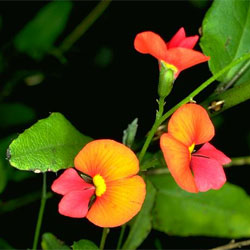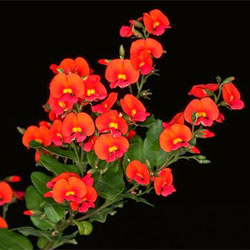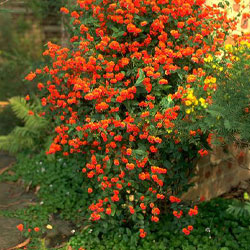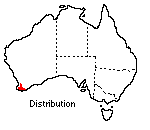Chorizema cordatum
 |
 |
 |
Flame Pea
The genus Chorizema contains approximately eighteen species and all but one are endemic to Western Australia. The generic name has been said to be derived from the Greek choros (dance) and zema (a drinking vessel), given by the botanist Labillardiere in 1792 when the plant was discovered near a waterhole by a thirsty expedition party. A more plausible explanation for the name is that Labillardiere constructed the name from chorizo (separate) and nema (a thread), referring to the free filaments of the flower and dropped the 'o' of chorizo and the 'n' of nema to make a better sounding name.
 Chorizema
cordatum, commonly known as the Heart-leaf Flame Pea, occurs naturally in
the forests of south-western Australia on gravelly or loamy soils. When in flower
this small scrambling shrub is conspicuous with its loose racemes of orange-red
or yellow pea flowers. The plant flowers in spring; the blooms are in racemes up to 12 cm long and are borne either terminally or in the leaf axils.
Chorizema
cordatum, commonly known as the Heart-leaf Flame Pea, occurs naturally in
the forests of south-western Australia on gravelly or loamy soils. When in flower
this small scrambling shrub is conspicuous with its loose racemes of orange-red
or yellow pea flowers. The plant flowers in spring; the blooms are in racemes up to 12 cm long and are borne either terminally or in the leaf axils.
The alternate leaves are often heart shaped, sometimes narrower, 3-5 cm long with slightly undulate margins.
In cultivation C. cordatum grows best in a well-drained, sandy soil with some shade. When given these conditions the species will form a slender, often scrambling shrub to 80 cm high and 1.5 m wide with thin, weak branches. Satisfactory growth has also been recorded on heavier clay soils. When planted in a shaded position, flower colours are deeper. Different forms of the species are available, including a yellow-flowered form. Some of the forms of Chorizema cordatum in cultivation may be hybrids with the closely related C. ilicifoium.
Propagation is best achieved from pretreated seed sown in spring or autumn in frost-free areas. Some success has been recorded from cuttings of semi-hardened material. Plants will generally flower at two to three years of age. Little maintenance is necessary once they are planted out apart from a light tip pruning and removal of old wood after flowering. Because the plants are delicately surface rooted, mulching and supplementary watering are necessary for plants in exposed situations. In Canberra, the species is slightly frost tender and requires protection from severe frosts. Some overhead tree shelter is usually sufficient. Serious defoliation caused by caterpillars has been noted on occasions and these may be controlled by spraying with Dipel, a bio-insecticide specific to leaf eating caterpillars. No other pests or diseases have been observed; however, those who wish to collect seed will have to watch for seed-eating insects entering the small, soft, inflated pod before maturity.
Although somewhat larger than other rockery plants C. cordatum could have a prominent position in a shadier corner. Its weak branches and scrambling habit allow the plant to be trained or trailed over rocks or other features. Outside the rockery the plant forms a spectacular understorey shrub.
Text by Ron Jackson, ANBG (1981)
Name meaning: Chorizema cordatumChorizema - possibly from the Greek, chorizo, I separate, and nema, a thread; cordatum - from the Latin, cordis, heart |
![An Australian Government Initiative [logo]](/images/austgovt_brown_90px.gif)

